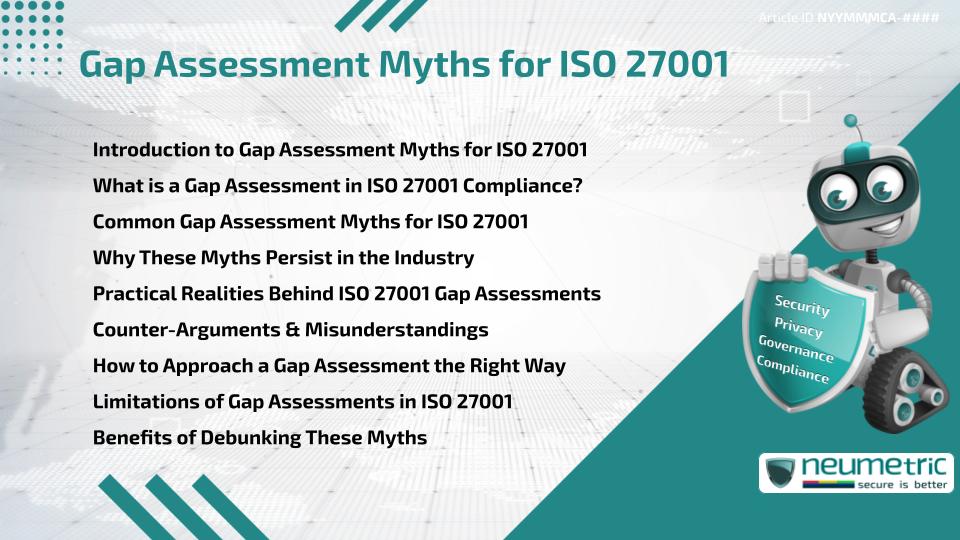Table of Contents
ToggleIntroduction to Gap Assessment Myths for ISO 27001
A gap assessment is often the first step many organisations take when preparing for ISO 27001 Certification. However, there are several widespread misconceptions that lead to confusion, unnecessary expense & poor decision-making. This article explores the most common gap assessment myths for ISO 27001 & offers practical guidance to separate fact from fiction.
What is a Gap Assessment in ISO 27001 Compliance?
In the context of ISO 27001, a gap assessment helps organisations compare their current Information Security practices against the requirements of the standard. It highlights where controls are missing or insufficient.
This review is part of establishing an effective Information Security Management System [ISMS] and can guide improvements. Learn more about ISO 27001 controls & the role of audits from the official ISO site.
Common Gap Assessment Myths for ISO 27001
Many organisations fall for myths that distort the purpose & value of the assessment. Some of the most common gap assessment myths for ISO 27001 include:
- “It guarantees Compliance.”
A gap assessment only highlights current gaps. It does not certify or guarantee anything. - “It must be done by a certification body.”
Certification Bodies perform audits, not assessments. A gap assessment can be done internally or by a trusted third party. - “One assessment is enough.”
A single review won’t reflect changes in infrastructure or practices over time. - “It should only happen at the beginning.”
Gap assessments can be useful at different stages, especially after major business or IT changes. - “It’s just paperwork.”
An effective assessment involves real analysis, not just documentation.
These myths can mislead teams & reduce the value they gain from assessments.
Why These Myths Persist in the Industry
The persistence of gap assessment myths for ISO 27001 can be traced to a few sources:
- Miscommunication by vendors or consultants eager to sell services
- Lack of in-house expertise or training
- Misinterpretation of the ISO 27001 Standard itself
- Confusion between assessments & audits
For example, many companies mistake a preliminary checklist for a full ISO 27001 gap assessment. This guidance from IT Governance clarifies the difference between Gap Analysis & certification audits.
Practical Realities Behind ISO 27001 Gap Assessments
The real-world function of a gap assessment is diagnostic, not definitive. It provides:
- A baseline of your current Information Security posture
- A way to prioritise remediation efforts
- Evidence to support budgeting or strategic planning
It is similar to a medical check-up—you get insights, not a cure. It’s important to combine it with other tools & approaches for best results.
Counter-Arguments & Misunderstandings
Some professionals argue that gap assessments are unnecessary if a company is already implementing controls. However, without a structured assessment, gaps can go unnoticed.
Others claim that Third Party assessments are biased or not useful. While some vendors might overcharge or deliver poor results, a well-structured Third Party assessment brings objectivity & experience. The key is selecting qualified professionals.
How to Approach a Gap Assessment the Right Way
To avoid falling for gap assessment myths for ISO 27001, businesses should:
- Define clear objectives for the assessment
- Choose between self-assessment or external help based on need
- Use checklists that align directly with ISO 27001 Annex A controls
- Document findings with Risk-based recommendations
- Revisit the assessment periodically or after changes
Limitations of Gap Assessments in ISO 27001
Gap assessments are not a silver bullet. They have limitations, such as:
- They do not verify implementation effectiveness
- They may miss context-specific Risks
- They rely on honest & complete information
- They can be subjective, especially if internally led
Acknowledging these limits helps in setting the right expectations & avoiding disappointment.
Benefits of Debunking These Myths
When organisations understand the truth behind gap assessment myths for ISO 27001, they are better equipped to:
- Plan their Compliance journey strategically
- Avoid wasting resources on unnecessary steps
- Focus on actionable improvements
- Communicate more clearly with Stakeholders & auditors
The ISO 27001 global adoption map also shows that informed approaches lead to better success across industries & countries.
Takeaways
- A gap assessment is a useful planning tool, not a Compliance certificate.
- Many organisations misunderstand its purpose, timing & scope.
- Recognising & rejecting common myths leads to better outcomes.
- A structured, realistic approach helps maximise its value.
- Combining the assessment with Continuous Improvement is key.
FAQ
What is the biggest myth about ISO 27001 gap assessments?
The biggest myth is that it guarantees Compliance. It does not. It only shows areas needing improvement.
Can a gap assessment be done by anyone?
Yes, it can be done internally or by an external consultant. A certification body is not required for this step.
Do I need to perform a gap assessment every year?
Not necessarily every year, but it should be repeated when major changes occur or before audits.
Is a gap assessment a mandatory part of ISO 27001 Certification?
No, but it is a best practice & strongly recommended to prepare for audits & certification.
How long does a gap assessment usually take?
Depending on the size & complexity of your organisation, it can take anywhere from a few days to several weeks.
What is the difference between an Audit & a gap assessment?
An Audit checks Compliance for certification. A gap assessment is internal & highlights gaps before the Audit.
Will a gap assessment include Risk scoring?
It can, but not always. Some assessments include a basic Risk matrix to prioritise issues.
Do gap assessments cover all Annex A controls?
They should, but this depends on the scope & tool used. Custom assessments might focus on selected controls.
Need help?
Neumetric provides organisations the necessary help to achieve their Cybersecurity, Compliance, Governance, Privacy, Certifications & Pentesting goals.
Organisations & Businesses, specifically those which provide SaaS & AI Solutions, usually need a Cybersecurity Partner for meeting & maintaining the ongoing Security & Privacy needs & requirements of their Clients & Customers.
SOC 2, ISO 27001, ISO 42001, NIST, HIPAA, HECVAT, EU GDPR are some of the Frameworks that are served by Fusion – a centralised, automated, AI-enabled SaaS Solution created & managed by Neumetric.
Reach out to us!


